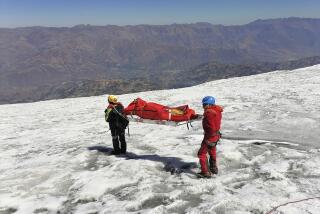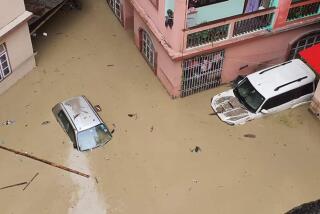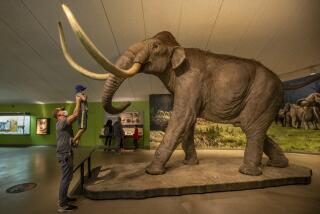Glacial Melting Takes Human Toll
- Share via
The entombment of a Russian village under 3 million tons of ice and mud from a collapsing glacier is a sign of the gradual yet vast climatic changes sweeping the world’s mountainous regions, scientists say.
The disaster on the slopes of the Caucasus Mountains on Friday left more than 100 people missing and at least nine dead. Researchers maintain that the avalanche is part of a subtle chain of events that has transformed once-frozen mountains and is altering the course of nearby human settlements in unexpected, and sometimes disastrous, ways.
The changes often have been difficult to perceive, because they have taken place over such a long period of time and because their effects are not always clear--some regions have become colder, even as others warm.
But scientists say there is little question that a world of ice is in flux.
Glacier National Park in Montana has lost more than 100 glaciers during the last century, vanished into a slow drip of runoff. In Venezuela, only two glaciers remain where there were six 30 years ago. In Tanzania’s Mt. Kilimanjaro, about 75% of the glacier has retreated, leaving some to suggest that Ernest Hemingway’s famous “Snows of Kilimanjaro” will exist only in literature in about a decade.
The United Nations Environmental Program completed a Himalayan glacier survey this summer that found dozens of mountain lakes in Nepal and Bhutan so swollen from melting glaciers that they could burst in the next few years, inundating villages throughout the region.
“I don’t think we fully understand the full extent of these impacts, but I’m convinced they’re happening,” said Tony Prato, an ecological economist at the University of Missouri. “People will adapt if they can, but it will be painful, and sometimes it will cost lives.”
The human toll has been largely overlooked in the debate over global warming. Much of the attention paid to climate change has focused on the Arctic and Antarctic, regions vulnerable to temperature change but sparsely populated.
The Russian disaster and growing changes throughout the world’s mountainous regions show that the warming of the world’s climate is beginning to affect areas much closer to home--temperate regions that are often densely populated. The last decade has brought some of the most rapid change of the century--seven of the last 10 years were the warmest on record.
“We have to start looking at the human dimension,” said Alton C. Byers, a mountain geographer who studies human effects on the Himalayas and Andes. “There are many unanticipated hardships for the future.”
Glacial avalanches are not the only worries. Other dangers include sudden glacial outburst floods that can release vast amounts of water in seconds. Drought and agricultural crises also are expected to follow the fading of mid-altitude glaciers.
Although little known, the changing face of the world’s mountain regions is of growing interest to scientists and land planners.
“We think of mountains as being pristine and unimpacted by global change, yet increasingly they are,” said Lisa Graumlich, a climate expert who directs the Big Sky Institute at Montana State University.
The collapse of the Maili glacier on the northern edge of the Caucasus Mountains ripped out trees and tossed massive trucks as if they were toys. It left a 20-mile path of rocky debris, blackened ice and devastation.
A full scientific assessment of what caused the disaster will take weeks or months, but Russian officials said this week that the collapse of the glacier seemed at least partly linked to climate change. It is a tricky issue because the collapse of glaciers can depend on a variety of near-term factors, including temperature, rain, humidity, slope and even the reflectivity of the glacial ice.
But during the course of a century, scientists say, glaciers in a wide range of locations around the world have undergone an enormous change in dynamics brought about by the human use of “greenhouse” gases, such as carbon dioxide, and the decades-long swings in ocean and atmospheric patterns that can greatly affect weather.
A 1998 study by University of Zurich researchers found that glaciers of the European Alps have lost about 30% to 40% of their surface area and about half their volume since 1850. Glaciers in the New Zealand’s Southern Alps have lost 25% of their surface area during the last century, according to another study.
U.S. experts said the Maili glacier incident followed the pattern of glacier collapse in other areas affected by rising temperatures.
“Glaciers tend to [collapse] like that when they’re receding, and glaciers are receding all over the world,” said Dan Fagre, an ecologist and expert on the ramifications of glacier loss at Glacier National Park in Montana.
The breaking off of huge chunks from a glacier is the sometimes spectacular result of a glacier that is gradually retreating back into the mountains. Glaciers grow only when the amount of snow they receive is greater than what they lose by melting. When there is less snowfall, higher temperatures or both, the “snouts” of glaciers retreat. Some of the ice breaks off in deadly chunks; some of it drips away as meltwater.
That seemingly gentle meltwater can be deadly as well. Such water often pools in the recess left by the receding glacier and piles up behind a weak natural dam of sediment and stone. Once there is enough water pressure behind the dam, it can suddenly burst in what is known as a glacial lake outburst flood, unleashing a torrent of water into villages below.
“We know it’s going to go shooting down the flood plain, and in a mountainous area, that’s where the people live,” said Graumlich of Montana State University.
The Dig Tsho glacial outburst in Nepal in 1985 destroyed a hydroelectric plant, wiped out 14 bridges and drowned dozens of villagers.
The danger is so obvious, Graumlich said, that some Himalayan villages have installed primitive warning systems--basically a system of horns--in attempts to save lives during the next flood.
“We’re just watching [glacial lakes] form in the Himalayas and Peru,” said Byers, director of research and education for the West Virginia-based Mountain Institute. “All you have to do is release that dam and you’ll lose vast amounts of water in seconds.”
Huascaran National Park in Peru has attempted to monitor and drain the lakes since they started to form in the 1950s, he said. But the pace of warming is making such work nearly impossible.
“One of the fears with warming is they’ll be forming so fast, no one will be able to keep a handle on it,” he said, “especially in countries that have no resources or glaciologists.”
Civilizations have long settled mountain valleys because of the continuous water supply that flows from the snowpack and glaciers and because of the rich soil that forms in such floodplains.
“The notion that agriculture co-evolved with glaciers is not surprising,” Graumlich said. Mountains also supply 50% of the fresh water that is consumed and furnish hydropower, said Prato of the University of Missouri.
As glacial melting proceeds, some farmers are enjoying the unexpected benefit of plenty of water. Farmers around Mt. Kilimanjaro have found the water supply so bountiful that they can grow far more than they need to survive. They are even growing foreign, water-thirsty crops such as tulips for export to Europe, Graumlich said.
But scientists point out that eventually the bounty of water will shrink as the ice disappears.
“More water now means more agriculture,” Graumlich said. “But what will they do when there is much less water later on?”






